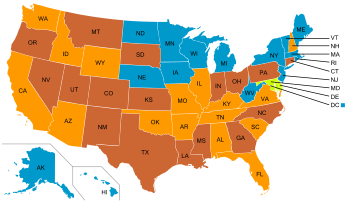U.S. Supreme Court hears arguments on constitutionality of lethal injection
Monday, January 7, 2008

The U.S. Supreme Court is hearing arguments on the constitutionality of the use of lethal injection as a method for the imposition of the death penalty in the United States. Two men, Ralph Baze and Thomas Clyde Bowling Jr., who were convicted of murder in the Commonwealth of Kentucky and sentenced to death, sued the state in 2004 arguing that the use of lethal injection as a method of imposition of capital punishment violates the Eighth Amendment's prohibition on cruel and unusual punishment.
Thirty-seven states and the Federal Government have capital punishment for some crimes, all except Nebraska (which uses electrocution) use lethal injection. The process uses three chemicals in a "cocktail", which, by the procedures that are used to apply them to the condemned, (three injections given consecutively) allegedly "create a significant and unnecessary risk of inflicting severe pain that could be prevented by the adoption of reasonable safeguards", their lawyers said in court papers. "Kentucky seeks to execute in a relatively humane manner and has worked hard to adopt such a procedure," Kentucky Attorney General Gregory Stumbo has said. The state has also argued in its brief against supporting the plaintiffs' appeal that it will lead to "an endless road of litigation. ... Condemned inmates will never run out of ideas for changes to the procedures, drugs or equipment used during lethal injection."
Baze was scheduled to be executed on January 8 after Governor of Kentucky Ernie Fletcher signed his death warrant, but the Kentucky Supreme Court suspended his execution on September 12, 2007, arguing it needed more time to examine arguments he had made in a separate appeal. He was convicted of killing Powell County Sheriff Steve Bennett and Deputy Arthur Briscoe in 1992 while the lawmen were trying to serve him with arrest warrants. Bowling was convicted of killing Edward and Tina Earley in Louisville in 1990.
According to the article on lethal injection in Wikipedia, the three chemicals used are Sodium thiopental to render the offender unconscious; Pancuronium/Tubocurarine: to stop all muscle movement except the heart, causing muscle paralysis, collapse of the diaphragm, and would eventually cause death by asphyxiation; and Potassium chloride to stop the heart. The chemicals apparently cannot be combined together as they could precipitate into a solid and be ineffective. It is argued that thiopental is a very short-term anesthetic and may wear off during the procedure, causing anesthesia awareness and excruciating pain from the effects of the other drugs.
In oral hearings today, the justices seemed skeptical that the chemical concoction causes extreme pain or that a better method was available. A lawyer for one of the plaintiffs argued that if insufficient anesthetic is given, when the inmate is given the paralyzing drug, they will experience agonizing pain, but be unable to react, and that it is even illegal in Kentucky to euthanize animals in this fashion. Some of the justices have considered sending the case back for further hearings to determine if a single barbiturate would be superior to the current method.
While the Supreme Court has examined the application of the death penalty many times over the past 40 years, this is the first time the court has reviewed the issue of the method of execution in 100 years, according to lawyers for the plaintiffs. A ruling is not expected until June. There are about 3,000 people on death row in the United States, and about 60 are executed each year. Since the case was accepted by the Supreme Court, all executions in the United States have been temporarily suspended pending the decision.
The case name is Baze v. Rees.
Sources
- "US to decide on lethal injection" — BBC News, January 7, 2008
- David G. Savage. "High court takes skeptical view of lethal injection challenge" — Los Angeles Times, January 7, 2008
- Bill Mears. "Lethal injection goes before Supreme Court" — CNN, January 7, 2008
